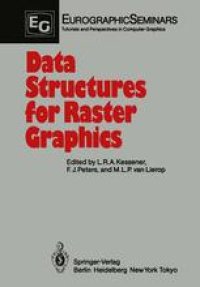
Ebook: Data Structures for Raster Graphics: Proceedings of a Workshop held at Steensel, The Netherlands, June 24–28, 1985
Author: Wm. Randolph Franklin (auth.) Laurens R. A. Kessener Frans J. Peters Marloes L. P. van Lierop (eds.)
- Tags: Computer Graphics, Data Structures, Computer-Aided Engineering (CAD CAE) and Design
- Series: EurographicSeminars
- Year: 1986
- Publisher: Springer-Verlag Berlin Heidelberg
- Edition: 1
- Language: English
- pdf
Raster graphics differs from the more traditional vector or line graphics in the sense that images are not made up from line segments but from discrete elements orderly arranged in a two-dimensional rectangular region. There are two reasons for the growing popularity of raster graphics or bit-mapped displays: I) the possibilities they offer to show extremely realistic pictures 2) the dropping prices of those displays and associated processors and memories. With the rise of raster graphics, all kinds of new techniques, methods, algorithms and data representations are associated -such as ray tracing, raster operations, and quadtrees-bringing with them a lot of fruitful research. As stated above raster graphics allows to create extremely realistic (synthesized) pictures. There are important applications in such diverse areas as industrial deSign, flight Simulation, education, image processing and animation. Unfortunately many applications are hampered by the fact that with the present state of the art they reqUire an excessive amount of computing resources. Hence it is worthwhile to investigate methods and techniques which may be of help in redudng computer costs associated with raster graphics applications. Since the choice of data srtuc tures influences the efficiency of algorithms in a crudal way, a workshop was set up in order to bring together a (limited) number of experienced researchers to dis cuss this topic. The workshop was held from 24 to 28 June 1985 at Steensel, a tiny village in the neighbourhood of Eindhoven, the Netherlands.
Content:
Front Matter....Pages I-VII
Problems with raster graphics algorithms....Pages 1-7
Display algorithms for quadtrees and octtrees and their hardware realisation....Pages 9-37
Intermediate data structures for display algorithms....Pages 39-55
Data structures for ray tracing....Pages 57-73
An approach for a PHIGS machine....Pages 75-90
Using linear quadtrees to store vector data....Pages 91-123
A model for raster graphics language primitives....Pages 125-142
Pattern representation....Pages 143-163
A 3D animation system....Pages 165-172
Applications of the method of invariants in computer graphics....Pages 173-180
Bibliography on quadtrees and related hierarchical data structures....Pages 181-201
Content:
Front Matter....Pages I-VII
Problems with raster graphics algorithms....Pages 1-7
Display algorithms for quadtrees and octtrees and their hardware realisation....Pages 9-37
Intermediate data structures for display algorithms....Pages 39-55
Data structures for ray tracing....Pages 57-73
An approach for a PHIGS machine....Pages 75-90
Using linear quadtrees to store vector data....Pages 91-123
A model for raster graphics language primitives....Pages 125-142
Pattern representation....Pages 143-163
A 3D animation system....Pages 165-172
Applications of the method of invariants in computer graphics....Pages 173-180
Bibliography on quadtrees and related hierarchical data structures....Pages 181-201
....